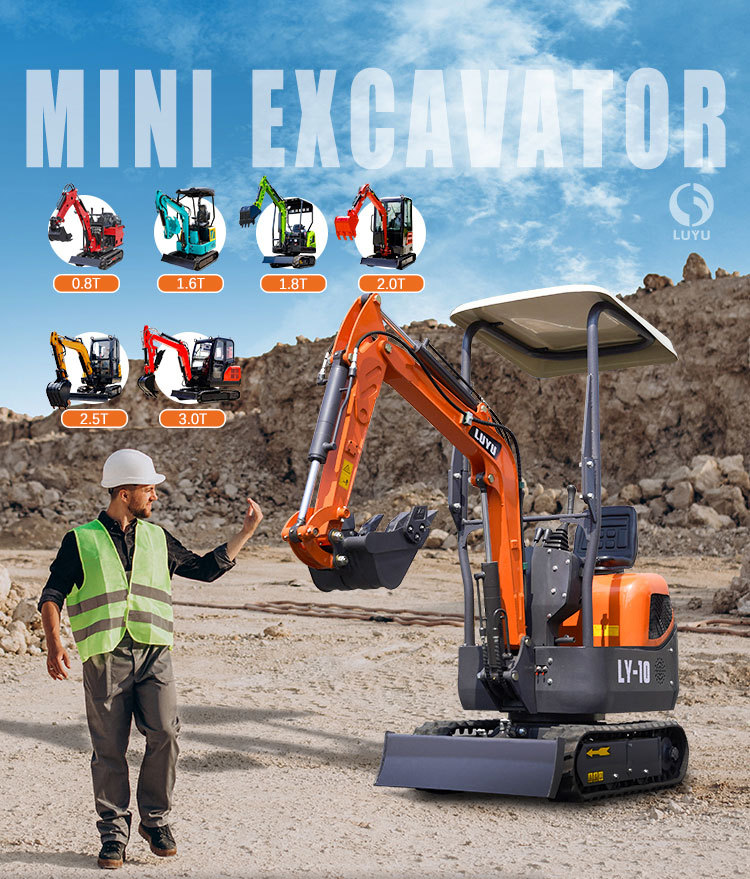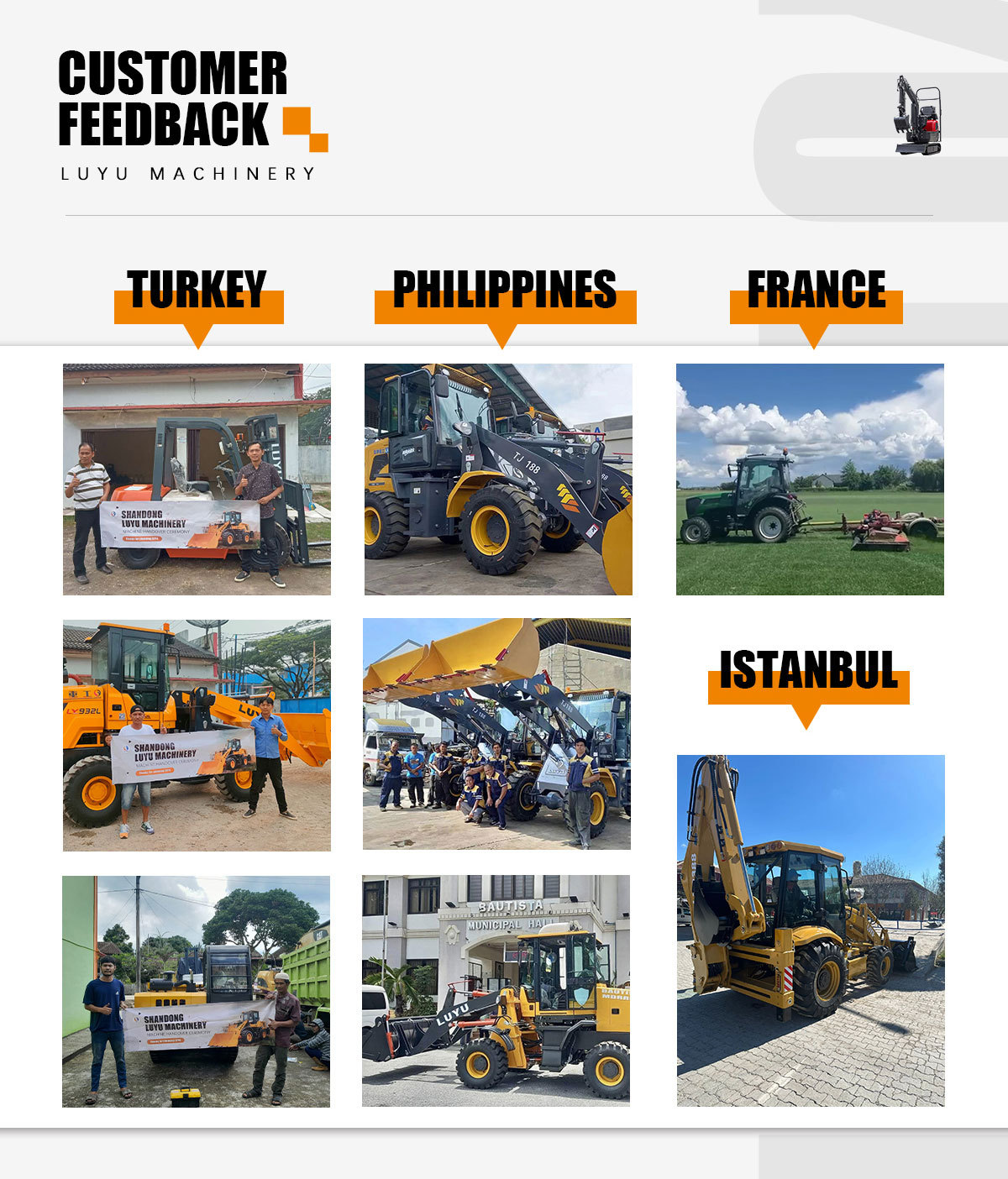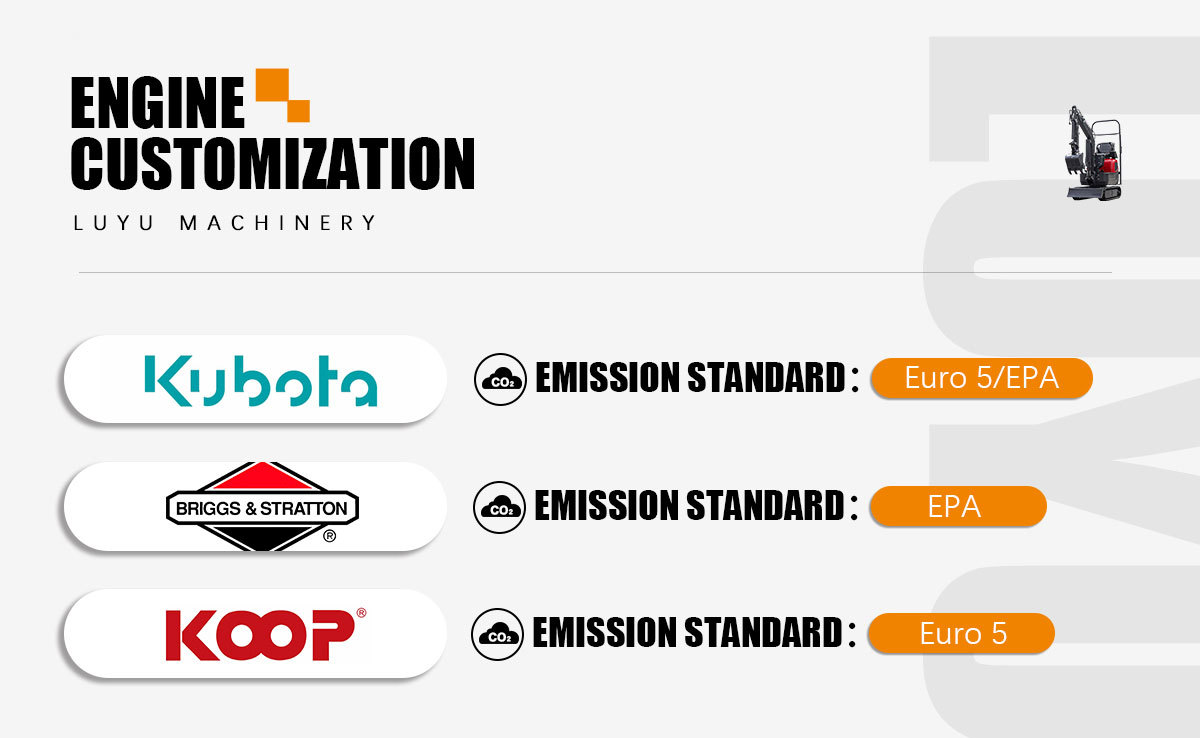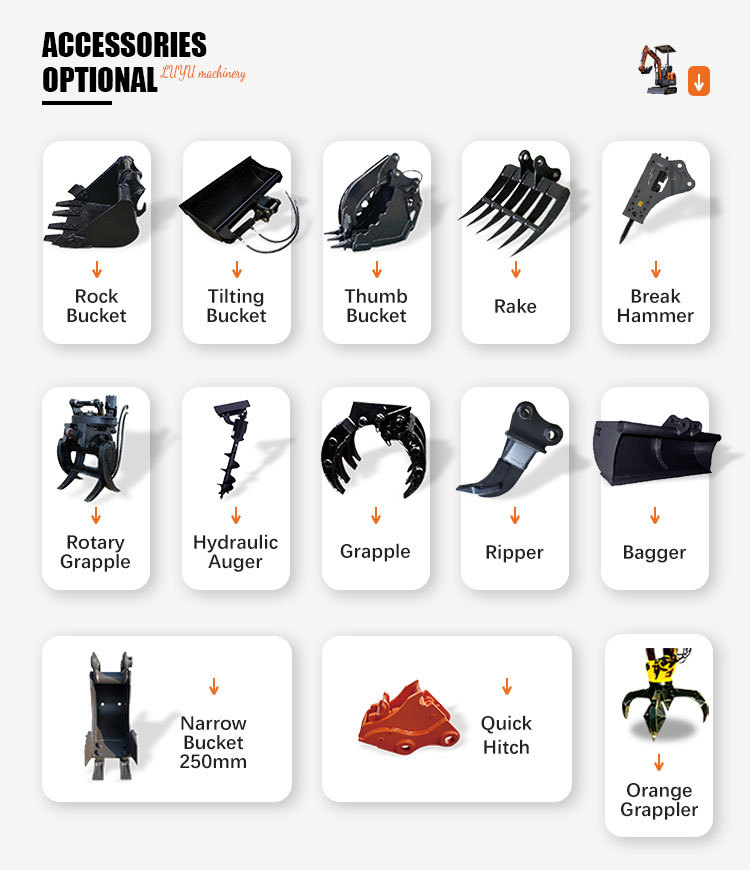It mainly produces wheel loaders, wheel excavators, mini excavators, Self-loading Mixer, backhoe loaders, telescopic wheel loaders, forklift, tractors ,Crawler Dumper and other construction machinery and agricultural machinery. In order to meet the market demand, Luyu Company has independently developed more than 100 new types of products and more than 100 kinds of supporting accessories. Scenario work requirements, simple operation and low fuel consumption, is a multi-functional product needed by all walks of life.
Tuesday, April 1, 2025
Sunday, March 30, 2025
LUYU Mini Excavators for Sale With CE-Certified Wheel & Track Models
As a leading mini excavator manufacturer with CE/ISO certifications, LUYU Machinery offers high-performance wheeled & tracked compact excavators. Explore technical specifications & OEM advantages.
Why Choose LUYU Mini Excavators?
Ⅰ. Engineered for Precision Performance
Customizable Configurations:
✔ Crawler type: LY10/LY20 series adopts adjustable crawler spacing (Adjustable crawler spacing 230-500mm), narrow space turning radius optimization (Steering boom for ≤35° slope operation)
✔ Wheeled: LY125 series is equipped with Side swing boom and wheelbase extension design (Wheelbase 2,900-3,600mm) to enhance the stability in urban working conditions.

Power Efficiency:
▶ Engine Options: Kubota (19-327HP) / CUMMINS Tier 3 compliant with EUStage V emissions▶ Hydraulic system: international brand components (KYB/Parker) LUDV dynamic balance system, digging force 7.5KN-244KN
Ⅱ. Industrial-Grade Durability
Structural reinforcement: Panasonic robot welding (weld molding ≥ 98% ASTM standard) + versatile laser cutting process
Tested and certified: Passed 12,000 hours MTBF test, compliant with EN ISO 12100:2010 Machinery Safety Directive and EN 60204-1 Electrical Code.
Ⅲ. Operational Advantages
Model Comparison
| crawler(LY35) | wheeled(LY135Z) | |
Operating Weight | 3,810kg | 8,300kg |
Digging Depth | 3,208mm(standard equipment) | ≥4,250mm(Multi-Terrain Kit) |
Engine power | Kubota 18.5KW | YUCHAI 62.5KW |
Advantages | Dirt grip | Road compliance |



Ⅳ. Global Service Network
▶ 3 years warranty on core components (hydraulic pump/walking motor)
▶ Global emergency parts delivery system
▶ Support ODM customization (50+ attachments such as quick-change couplings/breaking hammers, etc.)
CTA: Get LY-35/LY135Z product brochure and FOB quotation, exclusively enjoy MOQ discount policy for foreign trade customers.
Thursday, March 20, 2025
Unveiling the Mysteries of Oxidized Gold Ore Extraction
Gold has always held a special allure, captivating humanity for centuries with its beauty and value. While primary gold ore is often the first thing that comes to mind when thinking about gold sources, oxidized gold ore is a hidden gem in the world of mining. In this blog post, we'll take an in - depth look at oxidized gold ore, its properties, and the methods used to extract gold from it.
What is Oxidized Gold Ore?
Key Considerations for Extraction
- Grade: The grade of the oxidized gold ore is a crucial factor. It directly determines the economic viability of the extraction process. A higher - grade ore will yield more gold, making the operation more profitable. Geologists and mining engineers carefully assess the grade of the ore deposit before deciding whether to proceed with extraction.
- Mineral Composition: The mineral composition of the ore plays a vital role in choosing the right extraction method. Different minerals in the ore can interact with the extraction chemicals in various ways. For example, certain minerals might interfere with the leaching process, while others can enhance it. The presence of specific minerals also influences the choice of equipment. If the ore contains hard - to - process minerals, more robust and specialized equipment may be required.
- Physical Characteristics: Physical features like particle size and distribution, specific surface area, and porosity are equally important. Smaller particle sizes generally result in a higher specific surface area, which can enhance the efficiency of the extraction process. Porosity affects how well the leaching solution can penetrate the ore, ensuring that the gold - bearing minerals are fully exposed to the chemicals.
Extraction Methods
- Cyanide Leaching: This is one of the most widely used methods for extracting gold from oxidized gold ore. In cyanide leaching, a cyanide solution is used to dissolve the gold. The gold forms a complex with the cyanide ions, making it soluble in the solution. Once dissolved, the gold is then recovered by adsorption onto activated carbon. This method is highly effective but requires careful handling due to the toxicity of cyanide.
- Heap Leaching: Heap leaching is a more cost - effective option for low - grade oxidized gold ore. The ore is stacked in large heaps on an impermeable pad. A leaching solution, usually containing cyanide or other chemicals, is then irrigated over the heap. As the solution trickles through the ore, it dissolves the gold. The gold - bearing solution is collected at the bottom of the heap in a recovery system.
- Bioleaching: A relatively new and exciting method, bioleaching uses microorganisms to extract gold. These microorganisms are specifically selected to oxidize the remaining sulfide minerals in the ore. When the sulfide minerals are oxidized, the gold that was previously locked within them is released, making it available for extraction. Bioleaching has the significant advantage of being more environmentally friendly compared to traditional methods. It reduces the use of harsh chemicals and produces fewer harmful by - products.
Conclusion
Wednesday, March 19, 2025
Purification Methods for High-Purity Quartz: A Comprehensive Overview
High-purity quartz (HPQ) is a crucial material in various high-tech industries, including electronics, optics, and photovoltaics. The purification of quartz is essential to achieving the necessary purity levels required for these applications. Quartz purification methods are broadly classified into physical and chemical techniques. Each method targets specific impurities and plays a vital role in the refinement process.
Physical Purification Methods
Physical purification techniques primarily remove mineral impurities present in quartz as monomers. The most commonly employed physical methods include:
Scrubbing: This mechanical process helps to remove surface impurities and thin film contaminants.
Gravity Separation: Utilizes the density differences between quartz and impurities to achieve separation.
Magnetic Separation: Effectively eliminates iron-containing impurities using magnetic fields.
Color Separation: Distinguishes quartz particles based on their optical properties to remove visually distinct impurities.
Flotation: Employs chemical reagents to selectively separate quartz from unwanted minerals.
These methods effectively reduce impurity levels, but they are insufficient for removing gas-liquid inclusions and homogeneous impurities within the quartz crystal lattice.
Challenges in Achieving Ultra-High Purity
Even after rigorous physical purification, certain impurity elements, such as alkali metals (K and Na), remain embedded within the crystal lattice. These impurities negatively impact the performance of quartz glass by lowering its service temperature, reducing mechanical strength, and accelerating devitrification at high temperatures. Physical methods alone cannot eliminate these deep-seated impurities, necessitating advanced chemical purification techniques.
Chemical Purification Techniques
Chemical purification processes play a crucial role in the deep refinement of quartz. The primary methods include:
Acid (Alkali, Salt) Treatment: Removes surface and embedded impurities through dissolution in strong acid or alkali solutions.
Heat Treatment: Utilizes high temperatures to volatilize impurities, including isomorphic substitutions within the quartz lattice.
While chemical purification methods are more complex and expensive than physical techniques, they are indispensable for producing high-purity quartz. Among these, chlorination roasting has emerged as the most effective technique for removing interstitial atomic impurities and alkali metals.
Chlorination Roasting: The Key to High-Purity Quartz
Chlorination roasting is a widely adopted method for purifying quartz by converting impurity ions into volatile chlorides that can be efficiently removed. The process involves heating quartz sand in the presence of a chlorinating agent under controlled atmospheric and temperature conditions.
Commonly used chlorinating agents include:
Chlorine (Clfl)
Hydrogen chloride (HCl)
Ammonium chloride (NH₄Cl)
Sodium chloride (NaCl)
Potassium chloride (KCl)
Calcium chloride (CaCl₂)
The chlorination roasting process can be categorized into different temperature-based methods:
High-temperature roasting (Chlorination volatilization method): Operates at extreme temperatures to directly volatilize impurities.
Medium-temperature roasting (Chlorination roasting-leaching method): Involves moderate heating followed by impurity dissolution through leaching.
Chlorination-isolation: Focuses on selective removal of specific elements.
Traditional Chlorination Roasting Technology
In conventional chlorination roasting purification, quartz sand is typically heated to 1000-1200°C in a Cl₂ or HCl gas atmosphere. At these elevated temperatures, trace metal elements such as Al³+, Fe³+, and Ti⁴+, which are bound within the quartz lattice, diffuse towards the surface. These elements then react with Cl- ions to form volatile chlorides, which are swiftly eliminated, significantly enhancing the purity of quartz.
Conclusion
The purification of high-purity quartz is a multi-stage process that involves a combination of physical and chemical methods. While physical purification effectively removes external mineral impurities, chemical purification, particularly chlorination roasting, is indispensable for achieving ultra-high purity levels. Continued research and technological advancements in quartz purification are critical for meeting the ever-growing demands of high-tech industries.
Thursday, March 6, 2025
3ton compact wheel loader: flexible and efficient, has become a popular choice in the industry
In the small loader market, the 3-ton model has become the first choice of many users with its unique advantages. Whether it is a construction site, farmland operation or logistics warehousing, 3 tons of small loaders can easily cope with. luyu will provide you with a comprehensive analysis of why 3 tons small loaders are so popular from the comparison with other tonnage models, domestic and international industry situation and product advantages and selling points.

PARAMETERS
| Engine type | Yuchai6105T 92KW/123HP |
| Bucket capacity | 1.5m³ |
| Dumping height | 3800mm |
| Rated load | 3000kg |
| Total weight | 8580kg |
| Bucket width | 2400mm |
| Overall size | 7550*2470*3350mm |
| Minimum ground clearance | 430mm |
| Tyre | 17.5-25 |
Comparison of 3-ton compact loader with other tonnage models
1. Comparison with 1-2 tons models
Although 1-2 ton compact loaders are more lightweight and flexible, they are slightly less powerful and capable. In contrast, the 3-ton mini-loader offers more digging power and carrying capacity while maintaining a higher degree of flexibility, making it suitable for medium-intensity work tasks.
2. Comparison with 4-5 tons models
Although the 4-5 ton compact loader is more powerful and suitable for heavy-duty work, it is larger, less flexible, and has higher fuel consumption and
maintenance costs. 3 ton compact loader strikes a perfect balance between power and flexibility, which meets most of the operational needs without wasting resources.
3. Comparison of applicable scenes
1-2 tons model: suitable for light work, such as small farms, warehouse handling, etc.
3-ton model: suitable for medium-intensity work, such as construction sites, medium-sized farms.
4-5 tons model: suitable for heavy-duty work, such as mines, large construction sites, etc.
Global 3-ton compact loader industry situation
1. China Market
In China, 3 ton compact loader has become a popular choice for small and medium-sized enterprises and self-employed people due to its cost-effectiveness
and wide range of applications. In recent years, with the acceleration of rural construction and urbanization, the demand for 3-ton compact loaders continues to grow. Through technological innovation and cost control, Chinese brands have launched a variety of high-quality, low-cost 3-ton models, which are favored by users.
2. International market
In the international market, 3-ton compact loaders are also attracting attention. Europe and the United States focus on the environmental protection and
intelligence of the equipment, and many international brands have launched 3-ton models that meet the latest emission standards. Meanwhile, the demand for 3-ton compact loaders in developing countries is also growing rapidly, mainly for infrastructure construction and agricultural production.
Advantageous selling points of 3 tons compact loader
1. Flexibility and efficiency at the same time
The modest size of the 3-ton compact loader allows it to operate flexibly in confined spaces while providing enough power to accomplish moderately intense tasks. For example, the turning radius of a certain 3-ton loader is only 4 meters, which is ideal for operating in complex environments.
2. Low cost, high return
Compared with larger tonnage models, 3-ton compact loaders have lower purchase and operating costs. Its fuel consumption and maintenance costs are more
economical, making it suitable for users with limited budgets. At the same time, its efficient operating capacity can quickly return to the capital, creating more value for users.
3. Multi-functionalit
3 tons of small loaders are usually equipped with a variety of attachments, such as buckets, forklift frames, hydraulic hammers, etc., to adapt to different
operational needs. This multifunctionality not only improves the utilization rate of the equipment, but also saves the user the cost of purchasing additional equipment.
4. Durability and reliability
High-quality 3-ton compact loaders use high-quality materials and precision manufacturing processes to ensure that the equipment still maintains a long life
in harsh environments.
5. Intelligent and environmental protection
With the development of technology, many 3-ton compact loaders are equipped with intelligent control systems, such as automatic leveling, remote monitoring
and other functions, which further enhance the operational convenience and safety. At the same time, the engine that meets the latest emission standards also reduces environmental pollution and meets the needs of modern users for environmental protection.
With its flexibility, efficiency and versatility, the 3-ton compact loader has become the ideal choice for small and medium-sized operation scenarios.The 3-ton model shows strong competitiveness and broad prospects for development. If you are looking for a machine that can meet your operational needs and is also economical, the 3-ton compact loader is undoubtedly your best choice.
-
Coarse ore flotation has always been one of the key technologies for mine coarse grinding and flotation to reduce energy consumption. An i...
-
High-purity quartz (HPQ) is a crucial material in various high-tech industries, including electronics, optics, and photovoltaics. The purifi...
-
As a leading mini excavator manufacturer with CE/ISO certifications, LUYU Machinery offers high-performance wheeled & tracked compac...







